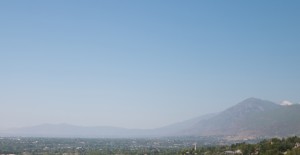
Air pollution in Utah isn’t confined to the winter months. Environmentalists say summer pollution is also a concern.
Salt Lake City, Provo and Orem are ranked on the most polluted cities list in the annual State of the Air report by the American Lung Association released in April.
It is no secret that the air quality in Utah is bad during the winter. The Wasatch Front experiences inversions when a cap of warm air sits above the valley, trapping pollution and particulate matter. People often overlook the pollution in Utah during the summer, and although it is less visible than inversions, it is equally as harmful to health.
Zachary Aanderud, a professor of plant and wildlife sciences at BYU, said air pollution in the summer months is caused by ground-level ozone. Ozone is created by light energy, volatile organic compounds and NOx pollution. Cars act as a major contributor to NOx pollution.
“Ozone is a big problem; you just don’t see it,” Aanderud said. “If you are exercising or spending time by busy roads in the summer, you are getting exposed to ground-level ozone.”
Ground-level ozone can be seen through photochemical smog, which is a big issue in cities like Los Angeles. Cutting down the amount spent driving is a great way to decrease the amount of ground-level ozone.
Aanderud explained several factors that go into the air pollution on the Wasatch Front.
“Utah is a special place because of the geography we have and the fast-growing population, many of whom drive in non-fuel-efficient cars,” Aanderud said.
Although the greater Salt Lake region is often ranked high in its air pollution, Salt Lake City was singled out for its efforts in improving air quality.
Ashley Robinson, a pre-communications major from Magna, Utah, is pleased with the efforts made by Utah to improve air quality, including requiring the Utah fleet of vehicles to run on natural gas or electric power.
“I think it is important to find a balance between passing laws to improve air quality and making it a friendly place for business,” Robinson said. “Utah has struck a good balance so far.”
Morgan Reese, a neuroscience major from Camas, Washington, spends a lot of time outside in the summer, so the air pollution is a concern for her.
“I think people forget about air pollution when the smoggy inversions are done for the winter,” Reese said. “I want to be able to go running and hiking in the summer and not feel like all of the pollution will hurt my lungs.”
Reese is one of many BYU students who take advantage of all of the outdoors opportunities in Utah. As the biggest polluter in Utah County, BYU has made efforts to help air quality, including burning natural gas in the winter and offering several classes that help educate students about pollution.
Aanderud commended Utah for its increased awareness of air quality index, but he warned students at BYU about ground-level ozone.
“Health effects for air pollution are felt by the very young and very old, but as a student I still wouldn’t run down busy roads during the summer when levels of ground-level ozone are high.”




